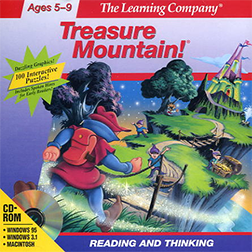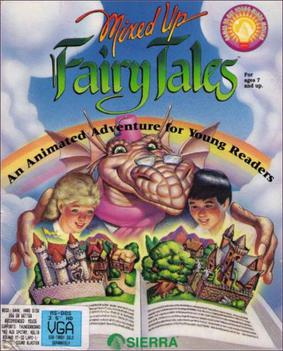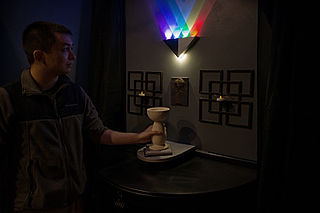
Hide-and-seek is a popular children's game in which at least two players conceal themselves in a set environment, to be found by one or more seekers. The game is played by one chosen player counting to a predetermined number with eyes closed while the other players hide. After reaching this number, the player who is "it" calls "Ready or not, here I come!" or "Coming, ready or not!" and then attempts to locate all concealed players.
I spy is a guessing game where one player chooses an object within sight and announces to the other players that "I spy with my little eye something beginning with...", naming the first letter of the object. Other players attempt to guess this object. It is often played as a car game.

The shell game is often portrayed as a gambling game, but in reality, when a wager for money is made, it is almost always a confidence trick used to perpetrate fraud. In confidence trick slang, this swindle is referred to as a short-con because it is quick and easy to pull off. The shell game is related to the cups and balls conjuring trick, which is performed purely for entertainment purposes without any purported gambling element.

A parlour or parlor game is a group game played indoors, named so as they were often played in a parlour. These games were extremely popular among the upper and middle classes in the United Kingdom and in the United States during the Victorian era.

Kick the can, is an outdoor children's game related to tag, hide and seek, and capture the flag, played with as few as three to as many as several dozen players. The game is one of skill, strategy, stealth, and stamina.

The Simpsons: Bart & the Beanstalk is a platform game released in February 1994 for the hand-held console Game Boy. It was developed by Software Creations and published by Acclaim Entertainment, and is based on the animated television series The Simpsons. The game is a parody of the fairy tale "Jack and the Beanstalk"; a large beanstalk grows far up into the sky outside the home of Bart Simpson, whom the player controls. Bart climbs the beanstalk all the way to the top and adventure ensues. Bart & the Beanstalk has received mixed to negative reviews from critics.
Soup beans is a term common in the Southern United States, particularly the regions around the Appalachian Mountains. Soup beans are usually served with cornbread, greens, and potatoes and may be topped with raw chopped onions or ramps. Soup beans are considered a main course, but also serve as a side dish. In rural areas, where food was scarce during the winter, these dried beans were a staple food.

Tavče gravče is a traditional Macedonian dish. It is prepared with fresh beans and can be found in many restaurants in North Macedonia. It is also commonly eaten by the Macedonian diaspora. This meal is baked and served in a traditional unglazed earthenware pot. The name of the dish may be translated as "beans on a tava". Tavče gravče is considered the national dish of North Macedonia. "Tavče gravče Tetovo style" is a popular regional variation.

Treasure Mountain! is an educational video game published by The Learning Company in 1990 for DOS, Windows and Macintosh. It teaches children aged five to nine reading, basic math, and logic skills. Treasure Mountain is the third installment of the Super Seekers series.

Mixed-Up Fairy Tales is a graphic adventure game released by Sierra On-Line in 1991. It is a follow-up to Mixed-Up Mother Goose and was made for younger players than those of Sierra's King's Quest or Space Quest series. In it, the player controls a child - selected from one of six and named at will by the player. Commercial copies of the game provided a fairy tale themed coloring book with a set of crayons.

Muscle reading, also known as "Hellstromism", "Cumberlandism" or "contact mind reading", is a technique used by mentalists to determine the thoughts or knowledge of a subject, the effect of which tends to be perceived as a form of mind reading. The performer can determine many things about the mental state of a subject by observing subtle, involuntary responses to speech or any other stimuli. It is closely related to the ideomotor effect, whereby subtle movements made without conscious awareness reflect a physical movement, action or direction which the subject is thinking about. The term "muscle reading" was coined in the 1870s by American neurologist George M. Beard to describe the actions of mentalist J. Randall Brown, an early proponent of the art.

An escape room video game, also known as escape the room, room escape, or escape game, is a subgenre of point-and-click adventure game which requires a player to escape from imprisonment by exploiting their surroundings. The room usually consists of a locked door, objects to manipulate, and hidden clues or secret compartments. The player must use the objects to interact with other items in the room to reveal a way to escape. Escape the room games were born out of freeware browser games created in Adobe Flash, but have since become most popular as mobile games for iOS and Android. Some examples include Crimson Room, Viridian Room, MOTAS, and Droom. The popularity of these online games has led to the development of real-life escape rooms all around the world.
Traditional Filipino games or indigenous games in the Philippines are games that have been played across multiple generations, usually using native materials or instruments. In the Philippines, due to limited resources for toys, children usually invent games without needing anything but players.There are different kinds of Philippine Traditional Games that are suited for kids, and the games also stand as one of the different culture and/or traditional games of the Philippines. These games are not only fun to play, but these games are also good for you. This is because different games require different skills. These games are also an important part in Filipino culture.

Smörgåsbord is a buffet-style meal of Swedish origin. It is served with various hot and cold dishes.

Duck, duck, goose is a traditional children's game often first learned in preschool or kindergarten. The game may be later adapted on the playground for early elementary students. The object of this game is to walk in a circle, tapping on each player's head until one is finally chosen; the chosen player must then chase the picker to avoid becoming the next picker.
Traditional games of Andhra Pradesh, like many other traditional games played in India, involve games which are played mostly by children. These games may also be enjoyed by other people of any age, as it reminds them of their childhood. Despite the advent of computers and technology, with children preferring to spend their times indoors, these games are still very popular in the Andhra Pradesh. They are also played in great and small towns all over India and Pakistan, especially in Andhra Pradesh, Tamil Nadu, Punjab, as well as Cambodia and Italy..

Blind man's buff or blind man's bluff is a variant of tag in which the player who is "It" is blindfolded. The traditional name of the game is "blind man's buff", where the word buff is used in its older sense of a small push.
Thai traditional games have been an integral part of Thai culture and traditions since ancient times. The Sukhothai period marked the earliest known traditional games in Thailand, as recorded in the stone inscription of King Ramkhamhaeng. Since then, Thai traditional games have evolved and been adapted over time, leading to the development of a wide variety of games across different eras. These games were originally designed to foster good relationships between adults and young people, as well as to provide entertainment, relaxation, and exercise. They are played with a set of rules and often feature music or songs to enhance the experience. Moreover, many traditional Thai games incorporate natural items such as sand, bamboo, rattan, mud balls, or banana tree stems, etc.













